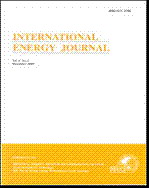ThaiScience
ThaiScience
INTERNATIONAL ENERGY JOURNAL
Volume 20, No. 03, Month SEPTEMBER, Year 2020, Pages 359 - 372
Cool and green roofs as techniques to overcome heating in building and its surroundings under warm climate
Hodo-Abalo Samah, G.N. Tiwari, Yawovi Nougbl?ga
Abstract Download PDF
In this work, cool and green roofs have been simulated as passive cooling techniques. The model considered for heat transfer modelling is a structure representing normal room. The mathematical model developed is governed by the energy balance on each isothermal layer. Heat transfer equations are solved using a finite difference scheme and the Thomas algorithm. The investigation is carried out under New Delhi climate conditions. Concepts of solair temperature, solar heat gain factor, decrement factor and thermal load leveling are used to investigate each technique. When considering cool and green roofs, the most important parameters considered for this study are solar reflectance and Leaf-Area-Index (LAI) respectively. Depending on cool or green roof, the peak value of solair temperature is reduced by 35℃ or 20℃ respectively. In best case, maximum solar heat gain factor is less than 30% for cool roof against 14% for green roof. Thermal load leveling decreases as the solar reflectance or the LAI increases. It’s clearer that, a larger solar reflectance or a great value of LAI reduces not only the heating in the building but also in it surrounding. The model has been validated with a previous experimental study, so it can be useful for engineer in optimization of such passive systems in practical buildings.
Keywords
cool roof; green roof; heat island mitigation; passive cooling.INTERNATIONAL ENERGY JOURNAL
Published by : Asian Institute of Technology
Contributions welcome at : http://www.rericjournal.ait.ac.th
